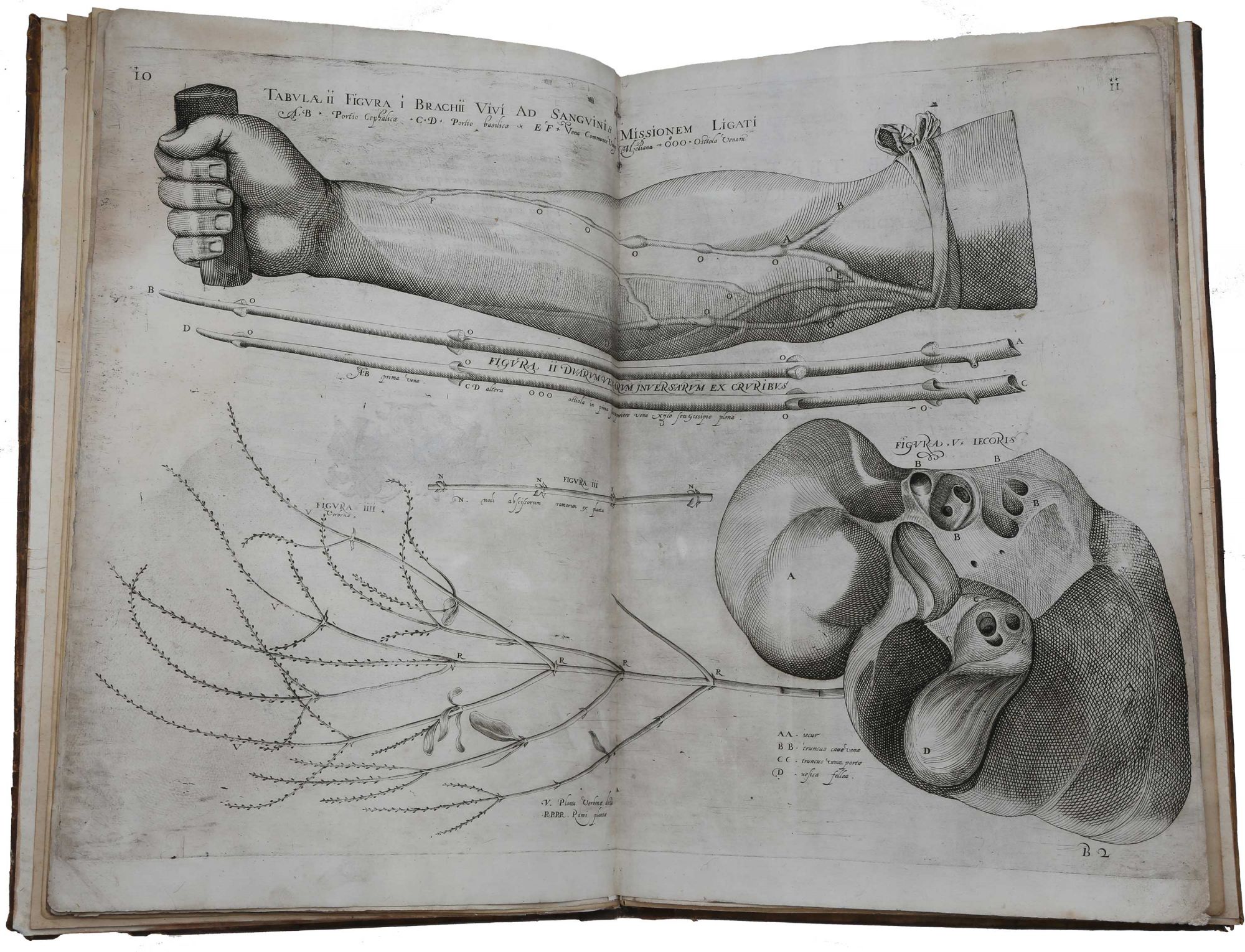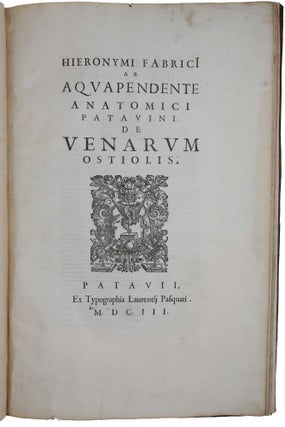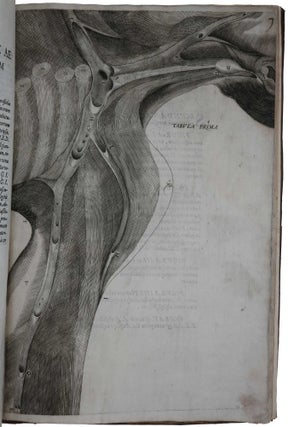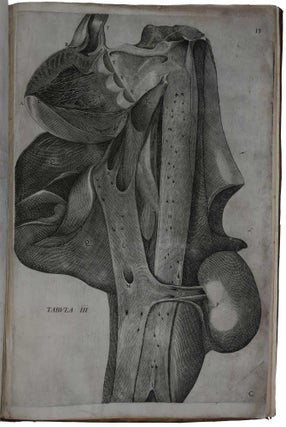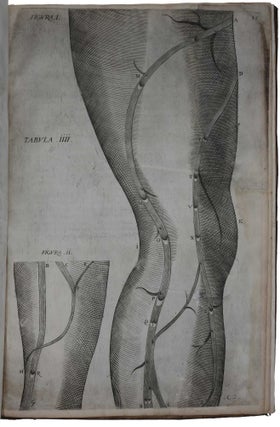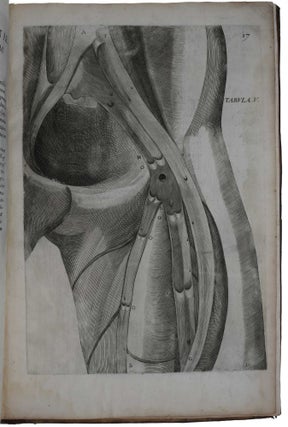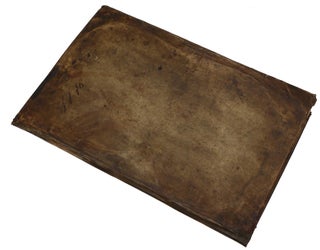De venarum ostiolis.
Padua: Lorenzo Pasquati, 1603.
First edition, very rare first separate issue (see below), “of the first systematic study of the structure, distribution and position of the venous valves. Although the valves of the veins had been observed previously by G.B. Canano and Amato Lusitano, Fabrici studied them anew on the basis of his own observations. Perhaps because he analyzed anatomical structures in terms of their purpose, he interpreted the function of the valves as slowing down the influx of blood in order to distribute it more evenly to the various parts of the body. Although Fabrici’s analysis was in part erroneous, De venarum ostiolis became his most influential work, in that it inspired his student, William Harvey, to conceptualize the circulation of the blood” (Norman). “The sumptuously printed folios which Fabricius published in 1603-1604 were issued separately, and unbound. Though they escaped Choulant’s notice, they are among the rarest and most beautiful works in the history of anatomical illustration. The plates are magnificent; in fact nothing on their scale had been seen since the days of Vesalius” (Franklin). The work is most often found bound as part of Fabricius’ Opera anatomica (1625), without a separate title page. Franklin cites only the Royal College of Surgeons, the Royal College of Physicians, the Radcliffe Library (Oxford) and the New York Academy of Medicine – all copies bound up under the 1625 general title but with the 1603 title preserved – and a copy without separate title in the library of the Royal Society of Medicine. Unlike the copy Franklin used for his facsimile, the present copy (like the Norman copy and the copy in the Royal College of Surgeons) does not bear the words ‘Superiorum Permissu’ at the end of the text on p. 22. Since this license note does appear, in the same position, in the other four treatises published by Fabricius in 1603 and 1604, it is reasonable to suppose that copies without the license are earlier than those with it. AE/RBH list only 6 copies since 1950.
“The first and foremost medium through which the influence of Padua on Harvey becomes palpable is the personality and teaching of the anatomical luminary of the school, Hieronymous Fabricius of Aquapendente (1537-1619). It was in 1603 that he published his treatise on the venous valves. He must have been occupied with it at the vey time when Harvey sat at his feet, namely between 1600 and 1602. It was a consideration of the arrangement of the venous valves in relation to the heart which, as Harvey told Boyle, touched off the spark of his discovery. The venous valves had been described before Fabricius, but the latter gave the first comprehensive anatomical account. He missed, however, the main point – their true function which is bound up with the centripetal direction of the venous blood flow. Fabricius remained an advocate of the Galenic assumption of its centrifugal direction, from the heart towards the periphery and the viscera. To have raised Harvey’s criticism would, then, constitute Fabricius’ main influence, as it also did with regard to essential questions concerning the generation of animals. It must be remembered, however, that Fabricius, the greatest pupil of the great Falloppio, the man who founded the celebrated Paduan Anatomical Theatre and School, could not have failed to direct his pupil’s interest into the proper channels of dynamic anatomy and to the very foci of his lifelong endeavor – the blood vessels on the one hand and the generation of animals on the other. For it is to both of these fields that much of Fabricius’ work has been devoted. In it the Aristotelian lead and especially the spirit of comparative anatomical enquiry is just as recognizable in Harvey’s work. Indeed, the latter nominated Aristotle and Fabricius as his “leaders” (Pagel, pp. 19-20).
“[De venarum ostiolis], published in Padua, consists of twenty-three folio pages, supplemented by eight beautiful plates. In it Fabrici reports that he had first observed the valves of the veins in 1574 (the first demonstration to his students was in 1578 or 1579), as was recognized by his student Salomon Alberti, who published, with Fabrici’s permission, a preliminary illustration of the venous valves (Nuremberg, 1585). Although the valves of the veins had been studied previously by G. B. Canano and by Amato Lusitano (indeed, a dispute arising therefrom had involved Vesalius, Eustachi, and Falloppio), Fabrici made no use of their contributions, perhaps intentionally; he describes the venous valves ex novo, systematically and accurately.
“His interest in reconciling his observations with the traditional Galenic concepts of function misled Fabrici into missing the real significance of the venous valves, however. He accepts the notion of the blood flowing centrifugally, drawn by the viscera, and interprets the function of the venous valves to be the slowing down of the influx of the blood to provide for its even distribution to various parts of the body. He thus gives a teleological account of the number, alternate positioning, and conformation of the valves, pointing out that they are not present in the large veins of the trunk, such as the vena cava, in which the blood flows directly to the viscera and vital organs; they are found instead in the veins of the limbs, where they prevent an excessive inflow of blood, which would both cause swelling and deprive the vital organs of nourishment. He describes the valves as corresponding to the openings of collateral branches of the veins and calls them ostiola. In addition to thus regulating the flow of the blood mechanically, the valves also serve to prevent excessive stretching of the blood vessels and to reinforce the walls of the veins.
“This is demonstrated by the formation of varicose veins in those who do heavy work; the blood of such persons is more dense and held longer by the valves, which become dilated, then subside as the veins dilate. The valves are further demonstrable by the application of a tourniquet to the upper arm; they then appear as a series of regularly spaced knots on its surface. Fabrici observed that if, after ligating the vein, one pressed upon it with a finger, one could observe the valves in action—acting, he thought, to retard the progress of the blood; his misinterpretation may have been due in part to his confusion of laboratory observation with the clinical symptoms of valvular insufficiency that he had noted, particularly in cases of varicosity.
“Perhaps the most notable contribution of De venarum ostiolis is that William Harvey drew upon it in beginning his studies of the circulation of blood. Harvey was the pupil of Fabrici—indeed, he even lived for a while in his house—and from Fabrici’s work he obtained the illustrations that would, with substantial modifications, serve him for his De motu cordis” (DSB).
Garrison-Morton 757; Grolier/Medicine 27B; Krivatsy 3831; Norman 750; Waller 2886. De Venarum Ostiolis, 1603, of Hieronymus Fabricius of Aquapendente (1533?-1619). Facsimile Edition with Introduction, Translation and Notes By K. J. Franklin, 1933; Pagel, William Harvey's Biological Ideas: Selected Aspects and Historical Background, 1967.
Folio (415 x 274 mm), pp. [ii], 23, [1], with one double-page and 7 full-page illustrations, printer’s device on title-page, without the phrase ‘Superiorum Permissu’ at the end of text on p. 22. Only little browned internally, marginal finger soiling to first pages, occasional light spotting, paper repair at lower gutter of leaf A1 not affecting text, closed tears on plates 4 and 8 repaired (without loss of image), plates 1, 2 and 3 trimmed at fore-margin just into plate mark (affecting a few mm of image on plate 1), double-page plate 2 mounted on stub, plate 3 with repair to top corner not affecting image. Bookplate of Birmingham Medical Library on front pastedown, a few unobtrusive stamps to some plates. Contemporary vellum (binding restored, boards heavily soiled, endpapers renewed).
Item #3909
Price: $85,000.00

